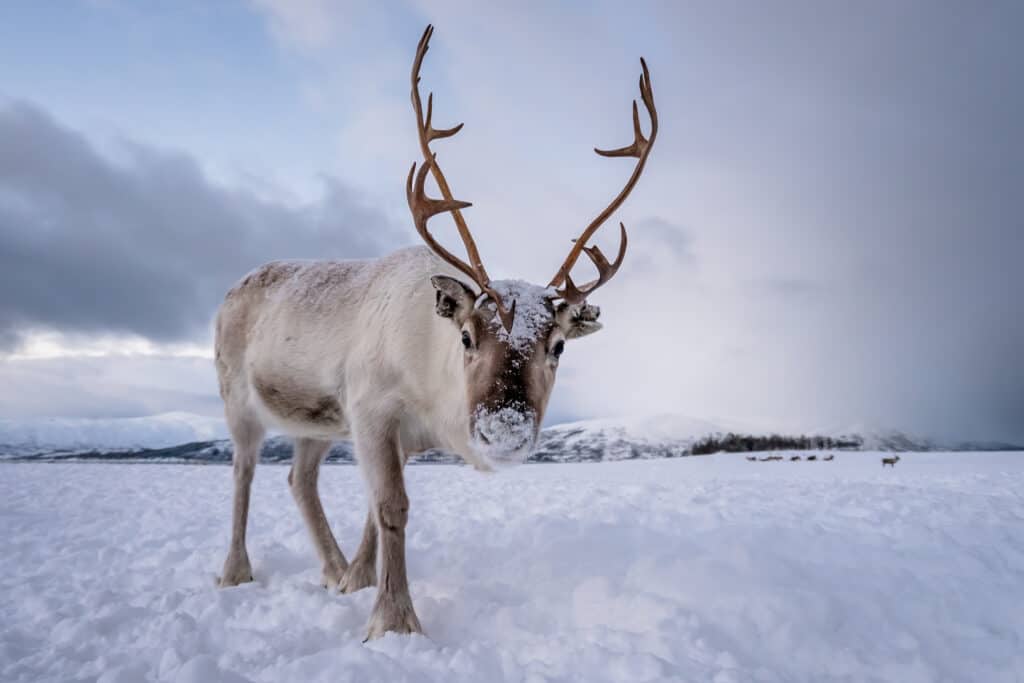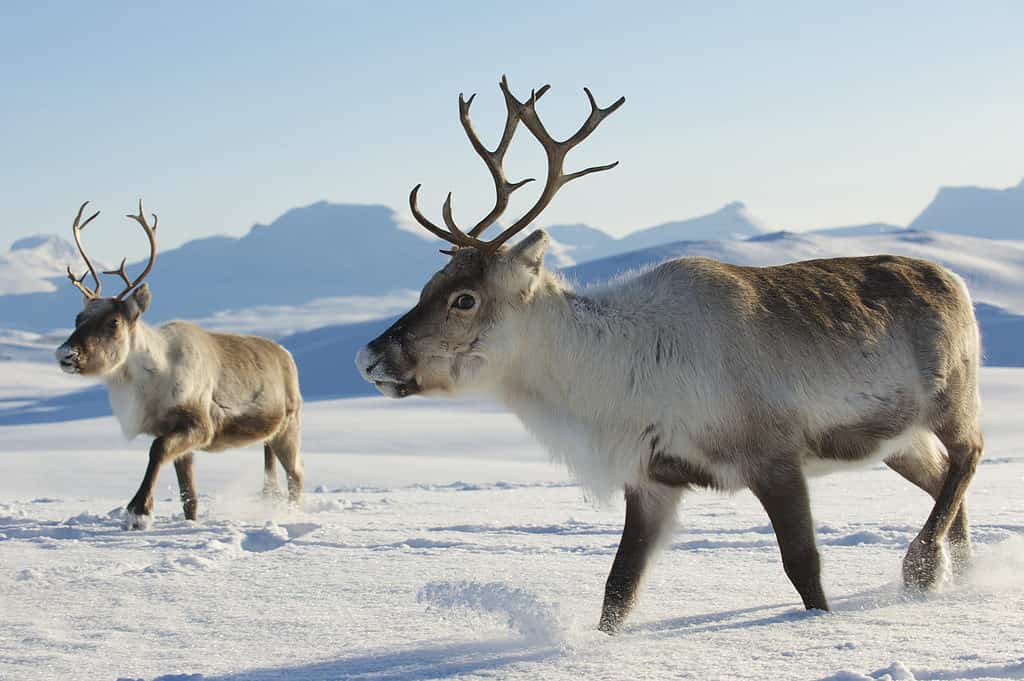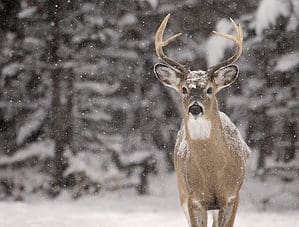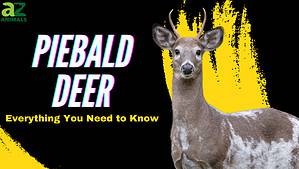Reindeer are a type of deer that evolved to endure harsh winters with freezing climates. An example is that they are the only deer species with hair completely covering their nose. This helps warm incoming cold air before entering the lungs. Reindeer also travel, feed, and rest together in the wild, sometimes forming super-herds of up to 500,000 animals.
Tundra reindeer migrate between forest and tundra in massive groups in an annual cycle. They typically move up north during summer and come back down south during colder seasons to feed and grow. They can live in hot weather, though with certain inconveniences, which we’ll explore further in the article.
Where Do Reindeer Live?

Reindeer and
caribou
are the same animals. They live in
North America
, Europe, and Asia.
©Tam and Trace Photography/Shutterstock.com
Domesticated reindeer, or caribou, can be found in ranch and farms across North America and Northern Europe and Asia. However, most of the reindeer population lives in the wild. You’ll find them roaming freely in the tundras and forests of the Northern Hemisphere. Their population is dispersed during the winter. Large herds pack together every spring, though, and travel considerable distances in an impressive journey.
Summer is considered the season of growth for reindeer. Calves quickly learn to follow their mothers and find food during this season. They suffer considerably, though, as the skin around their eyes doesn’t have much fur and is a target for insects. Still, reindeer tend to avoid getting too hot and will move further north during summer, back to more frigid areas.
Why Reindeer Migrate

Wild caribou in North America tough out the winters in the forests.
©Pav-Pro Photography Ltd/Shutterstock.com
In North America, wild reindeer will seek shelter and tough out the winters in the forests. They are well prepared to endure the cold and survive extreme winters. When the days become longer, they start an extensive journey in search of fresh food and to give birth. They usually begin traveling in small groups but pack together in huge herds along the way.
During the winter, they mainly feed off lichen, but as summer approaches, reindeer will also eat grasses and mushrooms, which become much more abundant in the northern lands when spring starts. They also have specific regions where they give birth to and raise their calves, which they revisit every year in their annual travel. In North America, the herds are even named after the traditional calving places they prefer, like the Porcupine River, Baffin Islands, Beverly Lake, and others.
When days shorten, and the snow starts falling again in the north, reindeer travel back south. The females leave much sooner than the males, who follow them weeks later, taking the yearling calves with them. When going back south, the herds start in great numbers, but the population disperses when they reach their destination.
Reindeer Migration Patterns And Facts

Reindeer’s cloven hooves grant them the ability to step on any type of terrain, including deep snow.
©Dmitry Chulov/Shutterstock.com
Reindeer are well adapted to survive the cold with their cloven hooves. These allow them to step on any type of terrain. Moreover, during the nighttime, the melted snow forms a light crust that is very easy for reindeer to walk on, making their pace steadier. Also, their eyes are adapted to the long nights of the northern winters, so they have no visual issues during the dark. They also possess a great sense of smell, which helps them find food in inhospitable regions.
Reindeer also make a particular sound with the bones in their legs as they walk. This sound can be described as a clicking. It is believed that this sound helps them find each other and stay together in the dark while also driving away predators.
Reindeer migration is not a programmed event. It’s impossible to know beforehand the exact day when they’ll start moving, as it depends not only on the amount of daylight time but also on the weather, the rains, and the depth of snow. These factors will also affect the speed at which the herds will move, so the migration path and duration, while similar each year, are somewhat unpredictable.
In addition, it’s been recently observed that climate change and human factors, like roads and railways, seem to have affected migration patterns. There are even some types of reindeer that have developed more or less sedentary habits.
Where Do Reindeer Go When They Migrate?
In Europe, reindeer spend their winters in the plains, where there is little snow, and the climate is not as extreme as in the arctic circle. Between April and May, they will travel up north in herds of thousands.
Sami people from Norway accompany the large herds during their travel as part of a tradition. They help the animals not get lost and even provide them with food when it’s scarce, making them a part of the natural cycle of reindeer. Some herds will end their travel in the Scandinavian Mountains, in the north of Norway, and others go to the coasts. There, they will raise their calves and will have fresh vegetation available thanks to the warmer climates.
In North America, caribou also move up north in their migration. Barren-ground caribou make a particularly long journey throughout the Yukon Territory until they reach the coasts of Alaska, where they’ll pasture and birth their calves. This annual migration is probably the longest of any land animal. They spend their winters in the boreal forests, move to their calving grounds in spring, and finally reach the tundra, where they’ll spend the summer feeding on the abundant vegetation.
The photo featured at the top of this post is © MM.Wildlifephotos/Shutterstock.com
Sources
- Britannica, Available here: https://www.britannica.com/animal/reindeer
- National Geographic, Available here: https://www.nationalgeographic.com/animals/mammals/facts/caribou
- Le Corre, Mael, et al., Available here: https://academic.oup.com/jmammal/article/98/1/260/2454646
- Northern Norway, Available here: https://nordnorge.com/en/artikkel/the-reindeer-migration-is-an-ancient-tradition-in-finnmark/
Thank you for reading! Have some feedback for us? Contact the AZ Animals editorial team.






